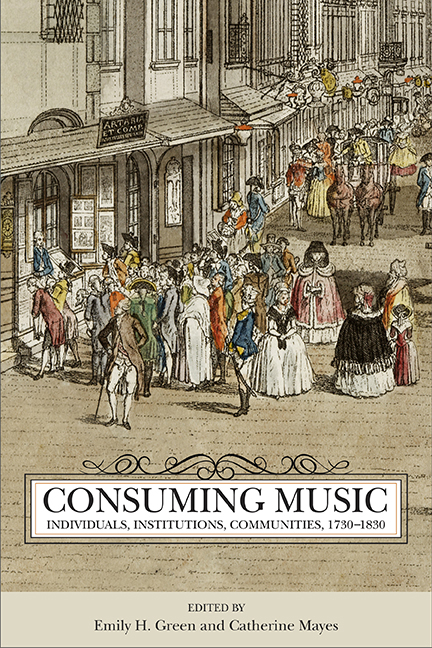Book contents
- Frontmatter
- Contents
- Acknowledgments
- Introduction
- Part One Selling Variety
- 1 Music's First Consumers: Publishers in the Late Eighteenth Century
- 2 Inside a Viennese Kunsthandlung: Artaria in 1784
- Part Two Edifying Readers
- Part Three Marketing the Mundane
- Part Four Cultivating Communities
- List of Contributors
- Index
2 - Inside a Viennese Kunsthandlung: Artaria in 1784
from Part One - Selling Variety
Published online by Cambridge University Press: 26 April 2018
- Frontmatter
- Contents
- Acknowledgments
- Introduction
- Part One Selling Variety
- 1 Music's First Consumers: Publishers in the Late Eighteenth Century
- 2 Inside a Viennese Kunsthandlung: Artaria in 1784
- Part Two Edifying Readers
- Part Three Marketing the Mundane
- Part Four Cultivating Communities
- List of Contributors
- Index
Summary
In Vienna around the turn of the nineteenth century, sales of various forms of print media—sheet music, engravings, books, and maps—were prominent and closely interconnected features of the commercial landscape. The relationship between media was easily articulated in the use of the word Kunsthandlung to describe many of the shops that printed and sold music. The literal translation “art shop” hardly conveys the broader meaning that would have been understood at the time, encompassing not only art but also everything regarded as “cultural,” including books, maps, music, and scientific gadgets like telescopes and geometric instruments. Thus the contemporary chronicler of Viennese life, Johann Pezzl (1756–1823), identifies fifteen Kunsthändler active in the city in 1822, selling “prints, drawings, maps, music, mathematical and optical instruments, colored inks, drawing materials, stitch and knitting patterns, visiting cards, games, books concerned primarily with prints, as well as paintings and busts.” In this way, one might say that the Kunsthändler sought to provide nourishment for the enlightened sensibility, in which the cultivation of music was but one strand in a portfolio of interests that also encompassed the desire to decorate one's home with engravings and curiosities and to view the world through both maps and topographical landscapes.
To what extent did this intermingling of the arts and sciences have an impact on the production, marketing, and sale of printed music? Were the different trades pursued entirely separately within each shop, or were they integrated to some degree? How did the Kunsthändler manage competing priorities and engage with different constituencies of consumers associated with different media? These questions have not been addressed in histories of music publishing or indeed in discussions of the art, book, and cartographic trades, which have largely pursued independent narratives without considering influences or dependencies in the wider commercial sphere. In part, this is a result of deficiencies in the evidential record: very few such establishments continued to trade beyond the nineteenth century, and in most cases their archives have simply not survived. Thus it is rarely possible to step beyond the threshold to explore the inner workings of a particular shop or to engage more deeply with the mechanics of the trade, beyond enumerating the items that were produced and sold.
- Type
- Chapter
- Information
- Consuming MusicIndividuals, Institutions, Communities, 1730–1830, pp. 29 - 62Publisher: Boydell & BrewerPrint publication year: 2017

